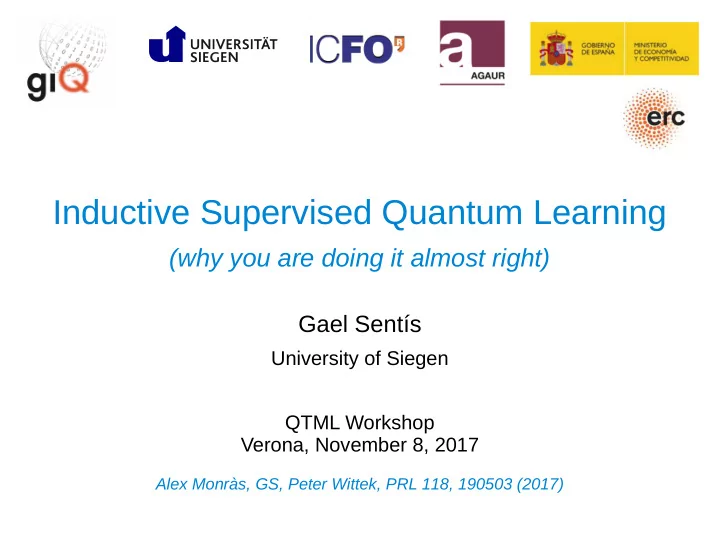

Inductive Supervised Quantum Learning (why you are doing it almost right) Gael Sentís University of Siegen QTML Workshop Verona, November 8, 2017 Alex Monràs, GS, Peter Wittek, PRL 118, 190503 (2017)
Inductive supervised learning Binary classification : attach labels to data We are given: ● Training set , sampled from ● Test instances Algorithm: inductive! Training Classification
Inductive supervised learning Binary classification : attach labels to data We are given: ● Training set , sampled from ● Test instances Algorithm: classical Training variable Classification
Inductive supervised learning Binary classification : attach labels to data We are given: ● Training set , sampled from ● Test instances Algorithm: QM implies... ● we can do coherent operations! Training ● limited use of the training set Classification
Inductive supervised learning Binary classification : attach labels to data We are given: ● Training set , sampled from ● Test instances Algorithm: QM implies... ● we can do coherent operations! Training ● limited use of the training set OK, but what advantage do Classification coherent measurements provide?
Inductive supervised learning Previous works: Semi-classical (C) strategies vs fully coherent (Q) ones States Approach Task C vs Q template [1] Pure qubits Bayesian C < Q matching [2,3,4] Mixed qubits Bayesian classification C = Q Minimax [5] Mixed qubits classification C < Q Semi-classical strategy: (LAN) [6] Coherent states Bayesian classification C < Q [1] M. Sasaki, A. Carlini, PRA 66, 022303 (2002) [2] J.A. Bergou, M. Hillery, PRL 94 160501 (2005) [3] GS, E. Bagan, J. Calsamiglia, R. Muñoz-Tapia, PRA 82, 042312 (2010) [4] GS, J. Calsamiglia, R. Muñoz-Tapia, E. Bagan, Sci. Rep. 2, 708 (2012) [5] M. Guţă, W. Kotłowski, NJP 12, 123032 (2010) [6] GS, M. Guţă, G. Adesso, EJP Quantum Technology 2015 2:17
General framework: Classical SL Given a training set and test instances , a learning protocol is a stochastic map
General framework: Classical SL Given a training set and test instances , a learning protocol is a stochastic map Its marginal maps are
General framework: Classical SL Given a training set and test instances , a learning protocol is a stochastic map Its marginal maps are We call a learning protocol inductive if the following nonsignalling condition holds: ➔ Each marginal map still depends on A ➔ This definition encompasses the standard assumption of inductive learning
General framework: Classical SL The quality of is measured by the expected risk Lemma: for every inductive learning protocol , there exists another inductive protocol where are stochastic maps, such that
General framework: Classical SL The quality of is measured by the expected risk Lemma: for every inductive learning protocol , there exists another inductive protocol where are stochastic maps, such that “Every conceivable inductive learning protocol can be regarded as a two-phase operation, training & test, with no effect on its performance” INDUCTIVE can be interpreted as applying = the marginal protocol NONSIGNALLING on each test instance
General framework. Quantum SL Nonsignalling is only a function of
General framework. Quantum SL Nonsignalling is only a function of
General framework. Quantum SL Nonsignalling is only a function of This framework includes several discriminative and generative quantum learning problems: ● Classification ● Generative algorithms
General framework. Quantum SL Error is measured by a s ymmetrized risk observable ↪ A symmetrized channel will have the same error: NONSIGNALLING
General framework. Quantum SL Error is measured by a s ymmetrized risk observable ↪ A symmetrized channel will have the same error: NONSIGNALLING If one could apply the conditional map to each of the test instances, one would perform on average as … ...but the map is nonlinear in !!! THE NO-CLONING THEOREM COMES INTO ACTION
General framework. Quantum SL Intuitive solution: The best we can hope for is some form of approximate cloning that distributes the system across identical parties Asymptotic cloning = estimate & prepare ⇒ measure + prepare a clone for each
General framework. Quantum SL Intuitive solution: The best we can hope for is some form of approximate cloning that distributes the system across identical parties Asymptotic cloning = estimate & prepare ⇒ measure + prepare a clone for each de Finetti theorem for nonsignalling quantum channels Let be a nonsignalling quantum channel, and let be a local operator. Then, there exists a POVM on and a set of quantum channels such that the quantum channel satisfies Where the coefficient depends on the dimensions of the spaces , , and .
General framework. Quantum SL
General framework. Quantum SL
Conclusions Take-home message: Despite QM in principle allows for much more, the two-phase separation TRAINING / TEST arises naturally for inductive quantum learning protocols from the (reasonable) requirement of being nonsignalling among test instances, for large data sets. ● Reduces a large class of quantum learning protocols to one-way LOCC ● Extensible to quantum operations instead of states ● Possible first step towards a quantum version of Structural Risk Minimization: appropriately process to assess the empirical risk → minimize VC bound PRL 118, 190503 (2017)
Conclusions Take-home message: Despite QM in principle allows for much more, the two-phase separation TRAINING / TEST arises naturally for inductive quantum learning protocols from the (reasonable) requirement of being nonsignalling among test instances, for large data sets. ● Reduces a large class of quantum learning protocols to one-way LOCC ● Extensible to quantum operations instead of states ● Possible first step towards a quantum version of Structural Risk Minimization: appropriately process to assess the empirical risk → minimize VC bound empirical risk ??? the interesting (?) risk PRL 118, 190503 (2017)
Recommend
More recommend